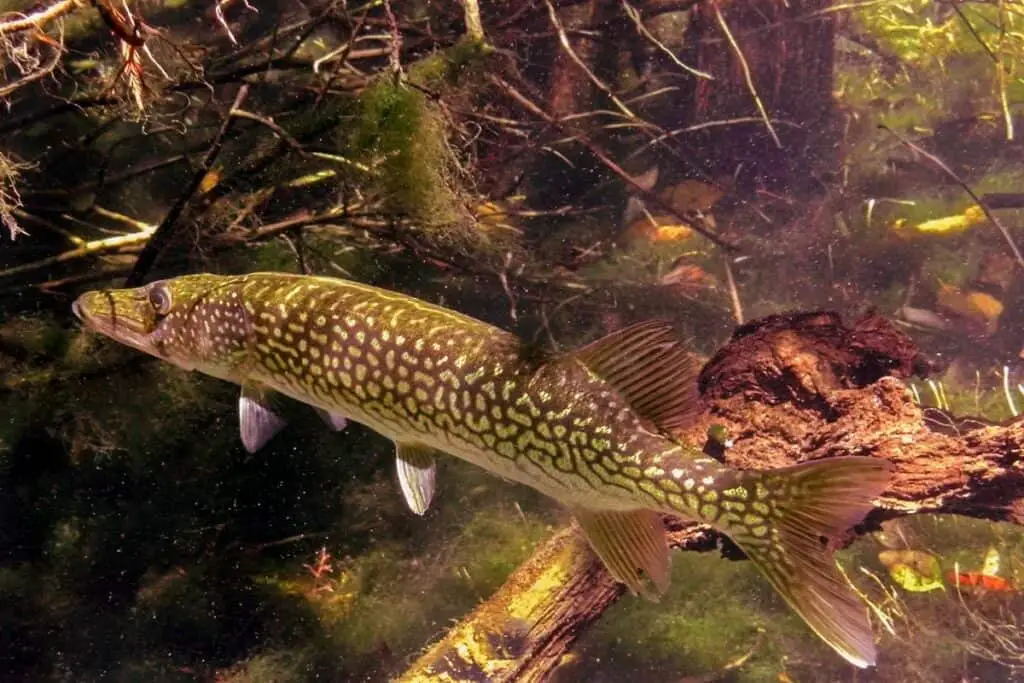What if you could keep a Pickerel fish as a pet? Yes, we all know that this esox species is an aggressive predatory fish. But news flash: Some aquarists have found that Pickerels can do well in community aquariums, despite initial concerns that they might not get along with other fish. Can this really be true?
Learn which tank mates are best suited for the Pickerel fish as well as its diet, lifespan, common diseases, temperament, and more.

Species Summary
Pickerels are pikes of the Esox genus, which are known to be highly aggressive.
They occur in lakes with a strong presence of clear vegetation, places with water without much movements, such as ponds and backwaters of small to large streams and rivers, and also swamps, usually with shallow waters. Other species inhabit deep and cold waters without the presence of any vegetation.
There are seven species contained in the genus — all have a high potential to be kept in aquariums. However, it is recommended only for aquarists experienced in maintaining fast, highly aggressive, and sizeable fish.
Pickerel Care Guide
This section of the article contains essential information on how to care for a Pickerel fish.
Tank Size
Pickerel is the only Esox species capable of being kept in home aquariums. Large aquariums, from 80 gallons, are enough to hold a specimen of this species.
Due to their large size, the other Esox species require large ponds or lakes, which are maintained externally. For Pickerels, use ponds from 500 gallons.
If you want to keep them in community tanks, at least double the proposed volume.
Tank Mates
The best tank mates for this fish are Sunfish, Stone Catfish, Carps, and other Pickerels. Smaller species might be eaten or used as prey.
Pickerels that rely heavily on sight to catch their prey use ambushing as a predatory strategy. They will lie motionless in vegetation or other forms of cover, then explode violently towards their potential meal. They exhibit both great speed and stealth depending on the situation, for example, appearing suddenly like a submarine behind a fly.
These fish prefer aquatic vegetation for cover, but if it is lacking in their habitat, they will also use other structures like stone or wood.
Same Species Tanks
Pickerels are aggressive predatory fish, so smaller species will be attacked. We recommend keeping this fish in a same-specie home aquarium (or keeping it with the best tank mates mentioned above).
Depending on the aquarium size, you can comfortably keep a small group of these fish.
Water Parameters
They are hardy fish that tolerate a wide range of parameters without problems. Pickerels will live in a degree of pH and hardness values but avoid extreme parameters.
The ideal for keeping them in an aquarium is a pH between 6.6-7.5, and 5-15 dH hardness should be adequate. As for the temperature, they are subtropical fish; they must be kept below 76 F. Otherwise, the fish will reduce their metabolism and live less.
Depending on the species, some cooling is necessary for very hot places to keep the water below 68 F.
What to Put in Their Tank
To keep these fish in tanks, decoration is not very important. The essential thing is that you provide ample space for them to swim freely.
Large vegetated areas also benefit this fish, which will be used as a refuge and to look for prey. They support well-lit tanks well. You can use both artificial and natural plants.
The substrate composition is indifferent to the species. Remember not to use substrates that will change the chemical composition of the tank.
The most crucial issue for Pickerels is the need for water flow, as you must keep these fish in low-flow waters in their biotope.
Common Diseases
Pickerels are incredibly resistant fish. But you can find some infections of viral origin, mainly in collected fish and internal and external parasites.
The so-called “Red Sore,” also called Epizootic ulcerative syndrome (EUS), is associated with these animals. It is a fungal disease, usually associated with bacterial infections.
You must be careful about the medications used; these fish are sensitive to some compounds, such as malachite green and dylox.
Food and Diet
It is a predatory fish, strictly carnivorous and essential piscivorous.
In captivity, it will mostly accept live food, mainly small fish. If you are patient, it is also possible to convert them to accept fresh food, churning fish pieces in front of them. Earthworms are also well taken, especially among the smallest Esox species.
Lifespan
They are relatively long-lived fish, easily exceeding 8 years when kept under ideal environmental conditions.
Appearance
All Pickerels have the same distinctive appearance as the other Pikes.
They have a body with a green base, showing spots usually of light tones, with circular or oval patterns. In some species, these patterns are reticulated or even close together.
The belly of these fish is light in color, almost always white, yellowish, or beige, extending over the whole lower part of the animal.
Long, robust, and hydrodynamic, they have only one dorsal near the beginning of the base of the tail; this fin is aligned with the anal fin.
Its mouth is long and pointed, with large size. These fish have teeth, which help capture prey.
Size
You can find these fish in different sizes, depending on the species. Esox niger, lucius, and masquinongy are the largest species, reaching lengths over 5 feet.
The different subspecies of Esox americanus (Redfin and Grass Pickerel) are medium-sized species, reaching around 15 inches. In aquariums, you hardly see individuals over 9 inches.
Behavior and Temperament
All species are solitary but get along well with each other despite cannibalism. It is not considered an exorbitantly aggressive or territorial species.
The depth of water they inhabit is directly related to the external temperature and, clearly, the time of year. In winter, they inhabit deeper waters.
They are ambush hunters, hiding among the vegetation and waiting for smaller fish to pass unnoticed in front of them. They can feed on prey half their size, something possible given the size of their mouths.
Moreover, males and females coexist without many problems, especially during spawning seasons. They are easily startled, so you should provide a strong and sturdy cover for your aquarium.
Breeding
These fish have not been widely domesticated, and there are few reports of their reproduction in domestic aquariums.
Spawning occurs in shallow waters such as grassy banks, swamps, and ponds, with the presence of dense vegetation.
They are egg-dispersing fish; they spawn freely in the environment and do not have parental care. Once dispersed, the eggs are fertilized by more than one male.
Additionally, water temperature plays a vital role in the reproduction of different species, being the main trigger for reproduction. The ideal temperature for the reproduction of different species ranges from 35 to 50 F, depending on the species. Keep in mind that this temperature is difficult to replicate in our aquariums.
Eggs hatch in a few days and reach the free-swimming state in 6 to 8 days, ready to feed. Young individuals, as well as adults, hunt actively through the ambush.
Gender Differences: Male vs Female
Pickerels of the Esox genus have no visible sexual dimorphism.
Pickerel Fun Facts
- These fish are highly adaptable and tolerant of the quality of the environment. They can withstand extreme acidity and high and freezing temperatures. Fishermen even find them in brackish water.
- The popular name Pickerel is the diminutive of Pike.
- Fishermen appreciate the different species of Pickerel for their fighting behavior after being hooked and their delicious meat.
- Some fishermen confuse their habits with those of the Walleye fish, which is not valid, as Walleye do not hunt by ambush and are nocturnal predators.
- Although tasty, these fish have excessive bones in their flesh.
- They have long teeth, which help to hold the prey, thus preventing it from escaping its fatal bite.
- An angler fished the largest recorded individual of Chain Pickerel in 1961 in Georgia; it weighed over 9 pounds.
References
Bailey, J., D. Sephton, W. Driedzic. 1991. Impact of an acute temperature change on performance of pickerel (Esox niger) and eel (Anguilla rostrata) hearts. Physiological Zoology, 64/3: 697-716.
DeJeane, J. 1951. Some factors affecting the reproduction of the chain pickerel, Esox niger Lesueur, in ponds (Master’s thesis). Auburn, Alabama: Alabama Polytechnic Institute.
Hoffman, G. 1967. Parasites of North American Freshwater Fishes. Berkeley and Los Angeles, California: University of California Press.
Hoyle, J. 2009. Chain Pickerel. Ontario Out of Doors, 10/41: 19.
Jenkins, R., N. Burkhead. 1994. Freshwater Fishes of Virginia. Bethesda, Maryland: American Fisheries Society.
NatureServe, 2013. “Esox niger” (Online). The IUCN Red List of Threatened Species 2013: eT202402A15363088.
U.S. Bureau of Fisheries. The Pikes: Their Geographical Distribution, Habits, Culture, and Commercial Importance. 853. Washington, D.C.: Washington Government Printing Office. 1917.
Underhill, A. 1949. Studies on the development, growth and maturity of the chain pickerel, Esox niger Lesueur. The Journal of Wildlife Management, 4/13: 377-391.
Werner, R. 2004. Freshwater Fishes of the Northeastern United States: A Field Guide. Syracuse, New York: Syracuse University Press.








